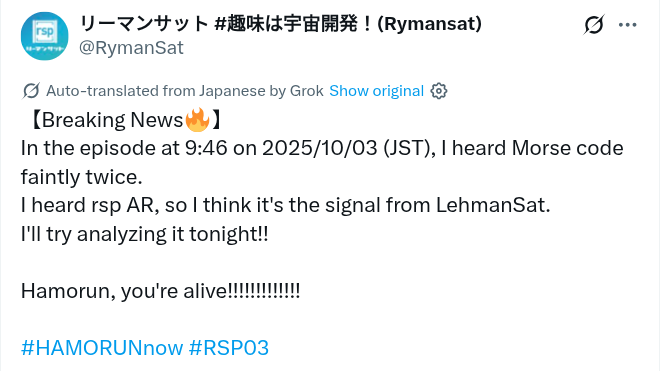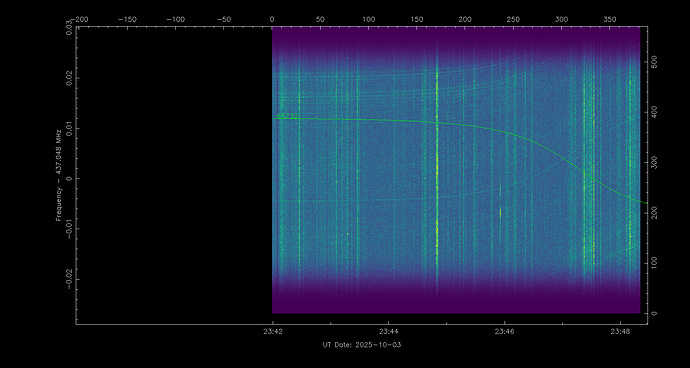Oops I forgot to link on the tool:
wow. so the ikhnos is not just word. but it was an amazing app. thank you! very useful
Hi all,
I’d like to monitor RSP-03 even when the TLEs may not be reliable.
I already run one SatNOGS station, but I also have another RTL-SDR + Raspberry Pi.
Since I don’t have much skill, I asked ChatGPT for ideas, and it suggested things like:
– running rtl_power to watch 437.050 MHz continuously,
– a second SatNOGS client with “frequency-only” jobs (if possible),
– or just using the Pi as a 24h IQ recorder.
Has anyone here tried something similar?
Any tips or better ideas would be really appreciated.
My simple goal is just to catch the CW beacon overhead without fully depending on TLEs.
czh00361(estima5633)
@estima5633 unfortunately there aren’t frequency only observations in SatNOGS.
About IQ, that would be the ideal but it will need a lot of storage, of course you can limit it only when the satellites are in your field of view.
Another solution would be to use STRF for example check the recent thread about it. While it will not give you the opportunity to decode the signals if received, in combination with the time and the frequency will give you a good hint which object is the satellite.
What’s the computer hardware available. For myself, I prefer to run the free (windows) SDR Console software. It allows me to record the IQ data from the SDR device (rtl-sdr in your case) and after the recording I ran the IQ file through the Data file analyser which also comes with SDR Console. That allows you to convert the IQ to a waterfall and zoom and scroll as you wish.
Let me add one example on which you have to zoom in to 100 percent to get the idea
Thank you very much for the suggestions. The STRF introduction and pe2bz’s explanation about recording IQ with SDR Console were very helpful. I’d like to first try recording some data with SDR Console myself over the weekend. It will take me some time, since I also need to set up an additional antenna, but I’d like to learn step by step and build up my skills with IQ data.
I also found Daniel Estévez’s STRF crash course (An STRF crash course – Daniel Estévez
) and I plan to follow it to experiment further. I’m enjoying learning all these new things!
By the way, since the launch on September 19, is there any chance that IQ data for RSP-03 might have been stored on some ground stations?
Thanks again for the guidance.
czh00361(estima5633)
I checked but I have removed all IQ from the sdr-console after generating the waterfall / heatmap.
Hi,@K4KDR,All
Thank you for sharing the post from our official X account.
We really appreciate if the SatNOGS community could also follow up on this case together with us.
As soon as we have more detailed analysis results, we’ll be happy to share them here as well.
czh00361(estima5633)
Rymansat project
This message contains everything for a classic rumor.
-
An Information is spread that people are eager to believe.
-
To prevent the message from being independently verified, important data are being withheld." (“I’ll try analyzing it …”) [The Japanese version has no subject.]
-
The rumor is given a nudge of about ten hours (9:46 → “tonight”), so that the truth will have a hard time catching up.
-
At first it’s “I think”, then two lines later the belief is turned into reality (“alive”).
-
The author of the message does not mention his/her name.
Hi, @dl7ndr.All
I am taking this calmly. As this is my first time participating in satellite observations, I can clearly see from the SatNOGS discussions how challenging the techniques are and also how rewarding it can be when signals are confirmed.
I would like to proceed carefully, just as dl7ndr suggested, and I am preparing tools such as SDR Console and STRF to verify signals by myself step by step.
Since I heard this satellite may only have a lifetime of 3–6 months, there is not much time, so I hope to continue with advice from everyone here. At the same time, I will try to convey the importance of being cautious to my RymanSat team members as well.
czh00361(estima5633)
Rymansat project
I’m transferring this from the matrix chat channel:
I did a quick revisit to the observations of some of the most sensitive stations in Network and I spotted this observation SatNOGS Network - Observation 12443847 where there is is something around 360-410 in the middle.
It looks like CW, unfortunately is not audible or visible to confirm that is RSP-03. Its duration is around 40s which is something expected from RSP-03 according to the given CW samples and with a quick check it looks like it fits the 63732 object, however with only this signal, we are far from any identification but it could be a start.
but he heard the morse code twice ![]()
We know that many RymanSat members have struggled in the past to distinguish CW beacons because the “DE + callsign + telemetry + AR” sequence was often buried in noise. For RSP-03, we are currently focusing on recognizing the “RSP AR” part as a clear marker.
At this stage, the satellite is still in test transmission mode, so we cannot yet release detailed information. However, in parallel we are also examining IQ data recorded with SDR Console. By zooming in and carefully separating signals from noise, we have been able to repeatedly decode not only the “RSP AR” part but also other fragments of the message. GMSK test signals are also being decoded with effort, even though it sometimes feels more like intuition than analysis.
As an additional note, our current results come from high-sensitivity reception using a Yagi antenna. Due to high noise and signal fading, the full “DE JS1YOY Telemetry RSP AR” sequence is not always audible, and therefore we cannot call this an official confirmation yet. Still, we believe there is no doubt that the satellite is indeed transmitting signals.
So far, the CW “RSP AR” has been observed three times, with matching evidence in both audio and spectrogram images.
We will continue careful verification and share updates as we have reproducible results. Thank you for your understanding.
thanks,Best Regards,
czh00361(estima5633)
Rymansat project
Unfortunately nothing seen 2250utc over the Eastern U.S., but at only 40° elevation, that is certainly not conclusive.
Will keep watching for it!
Hi,@K4KDR
“Thank you very much for checking! Yes, with only 40° elevation it’s not easy. We really appreciate your continuous monitoring support.”
czh00361(estima5633)
there is faint signal between -10 and 0
The graph above was created using STRF from the raw SatNOGS file. I just remembered that the raw files in SatNOGS have already been adjusted for Doppler. How do I reverse/remove this Doppler effect? Thank you.
look like same with here:


